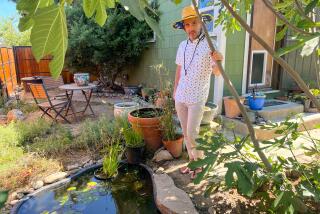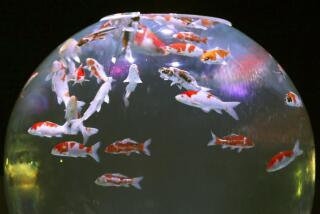In a watery landscape, flowers that swim
THIS garden could be a study in tranquillity. Slender reeds emerging from the pond’s surface form an elegant kimono pattern with the reflection of a pastel sky. An 18-inch koi streaks into view, its red and white blotches as gaudy as a clown suit. More fish soon follow. Their Japanese name, nishikigoi, translates as “brocaded carp,” and its aptness is apparent. There are fish whose scales glitter as though they have been embroidered with gold thread. Others are robed in thick swirls of jet black and glistening white.
The explanation for their arrival stands nearby: a fish food dispenser. Here at the Earl Burns Miller Japanese Garden at Cal State Long Beach, a quarter buys a handful of pellets, and the frenzy of leaping bodies and gaping mouths that greet this offering leaves no doubt that koi are descended from the legendary Chinese carp whose arduous mythical journey up a waterfall to the Dragon Gate has made it a widespread symbol of perseverance.
Southern California is an ideal place to get hooked on these auspicious fish. Not only is the climate favorable for keeping koi outdoors all year, but the region is also home to a legion of enthusiasts.
The Associated Koi Clubs of America lists more than half a dozen groups in Los Angeles and surrounding counties. They provide advice and encouragement to the novice setting up a koi garden as well as to the expert raising fish for competition. Many with merely a passing interest in koi soon find themselves in a highly specialized world -- one where prized specimens can cost more than the pond the koi call home.
IMAGES of koi and its ancestor, the common river carp, are everywhere in Asian culture. In Japan, families fly carp-shaped streamers called koinobori on Children’s Day in May. The bright-colored fish are a sign of good fortune (the number of streamers equals the number of children in the household) and a reminder of the obstacle-leaping that is required in any successful journey to adulthood. Chinese feng shui texts point out the beneficent effects of keeping a statue of carp in the home -- or, better yet, of having a pool of swimming koi.
To a gardener, the fish have something in common with camellias, another Asian specialty. All koi are one species, Cyprinus carpio, but fanciers recognize a bewildering number of varieties classified by color, pattern and the type or absence of scales. Recent introductions such as the platinum Ogon, an all-silver fish with the texture of quilted satin, are startlingly beautiful, but among traditionalists -- and especially among those who raise koi to show -- the vivid red and white fish known as Kohaku are particular favorites. The Japanese, first to breed river carp for decorative purposes, associate those colors with happiness and a bright outlook.
Lisa Barnett, president of the Nishiki Koi Club, based in Orange County, notes with approval another traditional preference -- that for female fish.
“It’s the only hobby where they want the women chubby,” she says.
The female koi’s silhouette, chunkier than the male’s, is said to offer a more satisfying image of robust vitality.
Regardless of their symbolism, koi’s grace and flower-like brilliance are a mesmerizing addition to a garden. Experts may argue about varieties, but the fish themselves are rampant individualists. Like snowflakes, no two koi look the same.
AT Westminster’s Eastern Nishikigoi, a licensed importer of Japanese koi, sales associate Nancy Morales walks to the back pools where the biggest fish swim. Koi grow rapidly under favorable conditions, reaching half their adult length in 24 months, and the 2-year-olds in these pools are already more than a foot long. In koi terms, though, they are still toddlers. Fish in well-designed pools can easily live 40 years. In Japan, some koi have topped 100.
Morales, who raises prize-winning koi with her pond-designer husband Frank, points to a pale gold behemoth rising from the pool’s depth.
“Here, Buttercup,” she calls. On either side of the koi’s O-shaped, expectant mouth, barbels -- sensitive, whisker-like appendages that distinguish true carp -- gleam like miniature ivory tusks. Buttercup is a 6-year-old, 34-inch Chagoi. With a price tag of $8,500, Morales explains, she is also the least expensive fish in the pool. In a Japanese competition last year, one entrant fetched $150,000 -- and that was before it won.
Best-of-show judges favor high-contrast patterns like those of a Kohaku or a Showa, a black fish with white and red markings. Still, Morales says, every koi pond needs a Buttercup. Known for their friendliness and hearty appetite, Chagoi (the name means “tea-colored”) exert a mellowing influence on other fish.
COLORED koi are a relatively recent phenomenon. An important food source since ancient times, carp were introduced to Japan from China before the Middle Ages. These ancestral koi were a monochrome black, but an occasional mutation produced a pale blue fish or one with a red belly. The freshwater fish were especially valued in the rice-growing regions of Niigata in northern Japan, where farmers raised them in indoor and outdoor pools to supply food during mountain winters.
In time, this close association of carp and man resulted in certain fish being kept as pets and bred for their appearance. Early versions of red and white Kohaku were noted in 1800, but koi remained a cult item among the wealthy until 1914, when a display at a Tokyo exhibition entranced the city’s residents.
The fish apparently made their Southern California debut as part of the Japanese pavilion erected in San Diego for the 1915 Panama-California Exhibition. Development of the hobby was hindered by World War II, which nearly wiped out Japanese koi.
The passion for the fish didn’t take hold here until the 1970s. According to Ken Tran, owner of Eastern Nishikigoi, sales have nearly tripled since then.
Today the region is home to a burgeoning network of pond designers and equipment suppliers, as well as what may be the country’s largest domestic koi farm, Koi Heaven, located in the Mohave Desert community of Newberry Springs.
Japan, however, remains the breeding ground of champions, and importers like Tran visit its mineral-laden mud pools in the fall to replenish their stock. Collectors eagerly await his return.
Most of the 2-year-olds swimming in the back pools have already been purchased, Morales says. Raising prize winners is not for the fainthearted. A Showa in this pool can cost up to $12,000, yet these tricolor koi can take years to develop their finished pattern. More than one gorgeous 2-year-old has grown into a frumpy adult.
DISEASE is a more serious threat. Koi herpes virus, better known as KHV, can wipe out a collection in 48 hours. Strict quarantine procedures and careful observation on the part of sellers and buyers are the best means of prevention -- and one reason the koi at Eastern Nishikigoi have not yet gone to their new owners.
Another virus -- spring viremia of carp, or SVC, which is somewhat less fatal to koi but threatens wild fish -- prompted the U.S. Department of Agriculture to institute new import rules this fall.
With inspections required for each shipment of fish, and permits issued only to those overseas breeders whose farms have been monitored for the last two years, Koi USA magazine foresees a rise in prices and difficulties in obtaining fish from smaller, specialty breeders.
Watching the koi play beneath the Earl Burns Miller waterfall, it’s hard to keep these dire specters in mind.
Multicolored fingerlings tumble over Humvee-like Chagoi; onyx and white dowagers rub shoulders with graceful butterfly koi -- a carp hybrid excluded from competition and shunned by traditionalists because of fluttery fins that trail like Victorian sleeves.
Prolific, adaptable and reasonably peaceful, koi are a happy reminder that while good luck is never guaranteed, an individual can always improve the odds.
*
(BEGIN TEXT OF INFOBOX)
Now, before you run to the store and buy some koi ...
A pond full of koi won’t last long if it’s not properly set up and maintained. Here’s what you need to know so these bright-colored fish can live for years to come.
Keeping koi
Think of a koi pond as an outdoor aquarium rather than a garden pool. To ensure good health, every koi home needs:
Sufficient depth: Local owners advise a minimum of 3 feet.
Sufficient size: One formula says each 10-inch fish requires 20 square feet of pond surface area. Because koi can reach 10 inches in two years, plan ahead.
Drainage: A proper system will rid pond of waste water.
Filtration: Koi grow rapidly and produce a lot of waste, which must be removed. A filtration system is essential.
Aeration: The pond needs a means of introducing oxygen to aid koi metabolism. Waterfalls do this, as do air pumps.
Conditioning: A water conditioner can correct for chemicals that are toxic to koi, such as chlorine.
Maintenance: This includes skimming debris, monitoring water quality and cleaning the filter system.
Costs
Do-it-yourself pond: Mystic Koi & Water Gardens in Upland (www.mystickoi.com) says a do-it-yourselfer hoping to build a pool to accommodate three or four fish can expect to spend at least $1,500 to $2,000 on supplies and equipment. Landscaping and koi are extra.
Professional pond: Professionally designed and installed water features for koi generally range from about $7,000 to $10,000 for a small pool with waterfall to $500,000 for an artificial, stream-fed, 20,000-square-foot mini lake. The region’s installers include California Waterscapes in La Crescenta (www.californiawaterscapes.com) and Exotic Aquatics in Redlands (www.exoticwaterscapes.com).
Fish: Koi don’t have to be expensive. A pretty, domestically raised 3- to 5-inch koi that has gone through quarantine and passed a pathogen test is $10 at Exotic Aquatics. Colorful year-old fish (tosai) that are 4 to 6 inches long, imported from certified Japanese breeders and quarantined after their arrival sell for $20 to $50 at Mystic Koi.
Some hobbyists purchase fish at the annual fall auction conducted by the Zen Nippon Airinkai Koi Club’s Southern California chapter and the Earl Burns Miller Japanese Garden at Cal State Long Beach.
Helpful hints:
Do set up your pond and condition the water before you buy a single fish.
Don’t confuse koi ponds with water gardens. Use plants with care. Koi will eat unprotected roots, muddying the pool while laying waste to the waterlilies.
Do protect koi from local wildlife. Pools with straight sides make it harder for raccoons and herons to wade in and chow down. Where predators are numerous, some owners employ an electric fence, but oftentimes water depth and proper pond design are enough to keep fish safe.
Resources
Eastern Nishikigoi: Koi importer’s website is www.enkoi.com.
Nishiki Koi Club: www.nishikikoiclub.com.
Associated Koi Clubs of America: www.akca.org. Has links to local clubs.
-- Ariel Swartley


